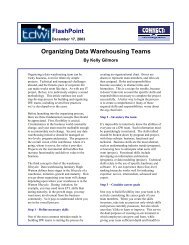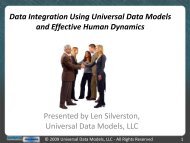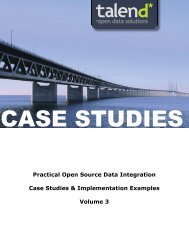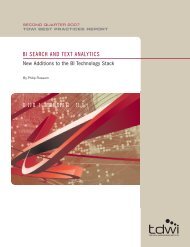THE RISE OF ANALYTIC APPLICATIONS:BUILD OR BUY?
THE RISE OF ANALYTIC APPLICATIONS:BUILD OR BUY?
THE RISE OF ANALYTIC APPLICATIONS:BUILD OR BUY?
- No tags were found...
You also want an ePaper? Increase the reach of your titles
YUMPU automatically turns print PDFs into web optimized ePapers that Google loves.
TDWIREP<strong>OR</strong>T SERIES<strong>THE</strong> <strong>RISE</strong> <strong>OF</strong> <strong>ANALYTIC</strong> <strong>APPLICATIONS</strong>: <strong>BUILD</strong> <strong>OR</strong> <strong>BUY</strong>?by Wayne W. Eckerson
<strong>THE</strong> <strong>RISE</strong> <strong>OF</strong> <strong>ANALYTIC</strong> <strong>APPLICATIONS</strong>: <strong>BUILD</strong> <strong>OR</strong> <strong>BUY</strong>?IntroductionIntroduction: Scope, Methodology, and DemographicsDemographicsA Definition IsNot EnoughQuestions Abound. There is considerable confusion today about analytic applications.Business intelligence professionals are understandably perplexed by this new term and areasking questions such as:• “How are analytic applications different from the decision support systems and toolsthat we’ve been using for years?”• “What are the benefits and ROI of buying a packaged analytic application comparedto building a custom analytic application?”Position25%10%65%Level11%11%15%11%52%The Analytic ApplicationsMarket Will Grow To $6Billion By 2005 - IDC• “Are the packages and tools for deploying analytic applications mature enough toinvest in them?”• “How do we differentiate the tools and packages for deploying analytic applicationsoffered by various vendors?”Market Size. Our industry deserves clear answers to these and other questions.Accordingto the International Data Corp., the market for analytic applications will grow from $2.5 billionto $6 billion by 2005.Without a basic understanding of analytic applications, moneyinvested in this new market may be misspent.Report Scope. This report attempts to answer the above questions about analytic applications.Specifically, it will explore what an analytic application is and what it is not. It willprovide criteria for evaluating analytic applications and discuss the pros and cons of purchasingan analytic package versus building a custom solution. Finally, it will offer guidelinesfor determining whether your organization should build or buy an analytic application.Methodology. The research for this report was conducted by interviewing industry experts,including consultants, industry analysts, and IT professionals who have implemented analyticapplications.The research is also based on a survey of business intelligence professionalsthat TDWI conducted in July and August of 2002.Survey Demographics. TDWI received 578 valid responses to the survey. Most were corporateIT professionals who work at large U.S. companies in a range of industries. Eighty-fourpercent of the respondents had deployed a custom or packaged analytic application, orwere planning to do so soon. (See the following illustrations for breakouts.)Respondents who identified themselves as vendors, professors, or students were not countedin the survey results. Respondents who were not planning to deploy an analytic application,or weren’t sure, were filtered from answering most questions. Respondents who “built”analytic applications were shown a different subset of questions from those who “bought”analytic applications.This filtering and branching logic accounts for most of the variation inthe number of total respondents to each question. Multi-choice questions and roundingaccount for percent totals that do not equal 100 percent.Company RevenuesIndustryCorporate IT professional (65%)Systems integrator or external consultant (25%)Business sponsor or business user (10%)31%13%Less than $10 million (15%)$10 million to $100 million (17%)$100 million to $1 billion (24%)$1 billion to $10 billion (31%)$10 billion + (13%)15%24%Consulting/Professional ServicesFinancial ServicesManufacturing (non-computers)Federal GovernmentSoftware/InternetRetail/Wholesale/DistributionHealthcareEducationInsuranceTelecommunicationsComputer ManufacturingFood/BeverageState/Local GovernmentOther Industries17%Countries16%4% 2% 10%9%8%7%6%6%4%4%4%3%3%Corporate (52%)Business Unit (15%)Division (11%)Department (11%)Does not apply (11%)USA (78%)Canada (4%)United Kingdom (2%)Other (16%)78%12%11%13%0 3 6 9 12 154 <strong>THE</strong> DATA WAREHOUSING INSTITUTE www.dw-institute.com<strong>THE</strong> DATA WAREHOUSING INSTITUTE www.dw-institute.com 5
<strong>THE</strong> <strong>RISE</strong> <strong>OF</strong> <strong>ANALYTIC</strong> <strong>APPLICATIONS</strong>: <strong>BUILD</strong> <strong>OR</strong> <strong>BUY</strong>?A New Old MarketThe Old Way:Apply Analytics ToFunctional AreasA New Old MarketThe term “analytic application”has emerged as an important new business intelligence trend.Yet,many business intelligence professionals are wondering if this term truly signifies something new,or whether it simply repackages existing analytic technologies and processes under a new banner.The truth is that the market for analytic applications is both new and old.What’s Old?For the past 10 years, business intelligence professionals have employed analytic technologiesand products—including data warehouses, query and reporting tools, OLAP products, datamining tools and algorithms, and visualization techniques—to deliver information and insightto business users. In most cases, organizations use these tools to create access methods andreports for specific functional areas, such as sales, marketing, finance, and manufacturing.What’s New?Four factors differentiate today’s analytic applications from previous generations of analytictools and applications.TDWI calls these the four “Ps” of analytic applications: (1) perspective,(2) process, (3) packages, and (4) platforms.1. Perspective. A true analytic application contains some level of domain knowledge abouta functional area, such as sales, marketing, or manufacturing, in a particular industry.Thebest analytic applications embody industry best practices represented as key performanceindicators or metrics within a set of predefined reports or report templates.For example, a procurement analytic application might provide a set of reports that helppurchasing managers optimize spending on materials for a manufacturing plant.The spendingoptimization reports will highlight best practice metrics, such as aggregate spendingper supplier on a global basis, average order value, and percentage of order volume purchasedoutside existing contracts.The Four “P’s” OfAnalytic ApplicationsMany business intelligence professionals may consider the results of these projects to beanalytic applications.And they are right—to a degree.These handcrafted solutions “apply”“analytic” technologies to business needs in specific functional areas.So, what’s new about an “analytic application” in the year 2002?“The real benefit of an analytic application is the domain knowledge or intellectual capitalit contains about a functional area,” says Bill Schmarzo, vice president of analytic applicationsat DecisionWorks Consulting and a TDWI faculty member who instructs on analyticapplications at TDWI conferences.Definitions2. Process. Another trademark feature of an analytic application is that it is… well… an application!Just as operational applications step users through a predefined business process, analyticapplications do the same for decision-making processes.Analytic Application—An analytic application enables business users to access, analyze, and act on information in thecontext of the business processes and tasks they manage. It embeds domain knowledge that supports the unique informationrequirements of users in a specific department or functional area.An analytic application is a complete solution that usually leverages a data warehousing environment, embeds analytictools, and employs business process logic. You can either build or buy an analytic application.What it’s not: An analytic tool (see below)Packaged Analytic Application – The “buy” option—A vendor-supplied package that provides domain-specific analytics. Itcontains an integrated set of analytic tools, data models, ETL mappings, business metrics, predefined reports, and “best practice”processes that accelerate the deployment of an analytic application in a given domain or across multiple domains.What it’s not: An analytic tool (see below)Custom Analytic Application – The “build” option—An analytic application that is primarily built using tools, code, or customizabletemplates to provide the exact look, feel, and functionality desired by an organization for its analytic environment.What it’s not: An analytic tool (see below).Analytic Development Platform (ADP)—A development environment that enables developers or savvy business usersto build custom analytic applications using predefined components, services, and/or starter kits in a graphical environmentthat minimizes coding and facilitates rapid prototyping and deployment.What it’s not: An analytic tool (see below).Business Analytic Tool (or Analytic Tool)—A tool that provides query, reporting, OLAP, or data mining functionality for endusers but offers little or no ability to extend or substantially customize functionality or the end-user environment.What it’s often called: A business intelligence tool or decision support tool.Business Intelligence—The processes, technologies, and tools needed to turn data into information, information intoknowledge, and knowledge into plans that drive profitable business action. Business intelligence encompasses datawarehousing, business analytic tools, and content/knowledge management.What it’s not: An analytic tool (see above).An analytic application is not just a bunch of reports or an analytic tool to perform ad hocqueries or create reports. It is a real application that provides transparent support for theanalytic processes that individuals and groups use to analyze data, make decisions, and acton plans.These analytic processes can be procedural, contextual, collaborative, event-driven,transactional, or evaluative. (See “Provides Decision Process Support” for more details.)In the past, organizations gave users an analytic tool, provided some training, and hoped forthe best.The result was usually failure or lots of underutilized software.A recent report byNigel Pendse and Survey.com discovered that organizations never deploy an astonishing 39percent of the OLAP licenses they purchase. 1Analytic applications promise to reverse this trend by embedding analytics into the fabric ofusers’ daily business processes and tasks. Users don’t have to wrestle with a tool to access, analyze,and act on information.They simply use an analytic application that supports their decisionmakingstyle, business processes, and collaborative activities in a seamless, intuitive fashion.3. Packages. In the past, organizations had to stitch together multiple products and componentsusing hand-written code to create an analytic application.Today, many vendors offerpackaged analytic applications that pre-integrate analytic and data warehousing components,including data models, ETL tools, meta data, analytic tools, reports, and portals.These packaged applications typically provide 65 to 85 percent of a complete solution, greatlyaccelerating and simplifying the deployment process. Most analytic packages are tailoredto specific functional areas, such as sales or marketing, or applications in vertical industries,Analytic ApplicationsTransparently SupportDecision MakingProcesses1 Nigel Pendse,“The OLAP Survey,” Published by Survey.com, July 2001. See www.survey.com.6 <strong>THE</strong> DATA WAREHOUSING INSTITUTE www.dw-institute.com<strong>THE</strong> DATA WAREHOUSING INSTITUTE www.dw-institute.com 7
<strong>THE</strong> <strong>RISE</strong> <strong>OF</strong> <strong>ANALYTIC</strong> <strong>APPLICATIONS</strong>: <strong>BUILD</strong> <strong>OR</strong> <strong>BUY</strong>?The Time Is Rightsuch as retail merchandising and assortment analysis.These packages embed domain knowledgeof specific functional or vertical applications in data models and reports.Evolution of Business AnalyticsAnalytic Applications AreNOT Just PackagesTraditional AnalyticTools are Hard-WiredMonoliths4. Platforms. But, contrary to public opinion, analytic applications are not just packagedsolutions.Today, organizations can just as easily build an analytic application as buy one.That’s because an emerging class of vendors offers specialized tools for rapidly buildingcustom analytic applications on top of an existing data warehouse or data mart.These tools—which TDWI calls analytic development platforms—enable developers orsavvy business users to build custom analytic applications using predefined components,services, and starter kits in a graphical environment that minimizes coding and facilitatesrapid prototyping and deployment. 2In contrast, most analytic tools (a.k.a. decision support tools or business intelligence tools)are hard-wired monoliths with a vendor-supplied look and feel—what you see is what youget.Administrators cannot easily modify the vendor’s GUI, add new functions, modify orextend existing functions, or dynamically personalize the end-user environment (e.g., GUI,functionality, or views) to fit the user or group.Complete Solution. In summary, an analytic application is a domain-specific analytic solutionthat integrates a diverse set of data warehousing and analytic tools that organizations previouslyhad to painstakingly stitch together.New packages and development tools enable organizations to rapidly deploy analytic solutionsthat address the unique information needs of knowledge workers in specific departments or linesof business.As applications, these new products provide built-in support for decision-makingprocesses that knowledge workers use to access, analyze, collaborate, and act on information.DashboardsExtranetsOptimizationVisualizationText AnalysisPortalsPredictive ModelingAlerts/AgentsReportingAnalytic SuitesHybrid OLAPEnterpriseReportingData MiningDesktopReportingRelational OLAP3GL ReportMultidimensionalWritersDatabasesEISSpreadsheetsAnalysisMainframes Client/server Web XML Web ServicesAnalytic Applications(Packages and Development Platforms)Simulation1980s 1990 1995 2000 2002+Illustration 1. Business analytic tools have evolved considerably since the 1970s and early 1980s when 3GL reportinglanguages, mainframe-based EIS systems, and spreadsheets dominated the landscape. Client/server reporting and analysistools converged in the 1990s to create analytic suites, which then migrated to the Web. Reporting and analysis tools willcontinue to evolve in specialized areas, such as performance dashboards and optimization algorithms, but the biggestareas of growth in the next several years will be in custom and packaged analytic applications.In many respects, the evolution of business analytics mirrors the way operational applicationsevolved from programming languages and toolsets to packages and development platforms.(See illustration 2.)BI Mirrors TheEvolution OfOperationalApplicationsThe Time Is RightAlthough analytic applications are still in their infancy, they represent the next phase in the evolutionof business analytic tools.Advances in technology,a heightening demand for holistic solutions,and enterprise-scale deployments are fueling the inexorable migration to analytic applications.Technology AdvancesDuring the past two decades, business analytic tools have evolved from mainframe reportinglanguages to desktop query, reporting, and OLAP tools to Web-based analytic suites.Along the way, organizations have deployed data warehouses to offload query processingfrom operational systems and provide a consistent set of data for end users to createreports and analyze data in an increasingly sophisticated fashion. (See illustration 1.)Vendors Deliver Greater Integration. Analytic applications are the next logical step in thistechnological progression.To increase the value of their products, vendors have continuallysought to integrate a larger number of the elements required to deliver a complete businessintelligence solution.These include infrastructure elements (e.g., data models, ETL, sourceadapters, data warehouses) and analytic elements (e.g., user interfaces, analytic engines,visualization tools, security services, broadcast servers, and portals).One difference is that the analytic applications market is evolving more quickly.This isbecause the SAPs of the world have already convinced many companies of the value of buyinga packaged application, paving the way for packaged analytic vendors. In fact, once companiesdecide to implement a packaged operational application, they are more likely toimplement a packaged analytic application at the same time or shortly thereafter to obtainthe full value of their new operational system. Consequently, the market for packaged operationalapplications has accelerated the market for packaged analytics.The Mainstream Is Ready!At the same time, the business analytics market has evolved from an early adopter market toa mainstream one. Gartner DataQuest estimates that the market for business analytic toolswill grow from $9 billion to $18.5 billion in 2005. 3 These figures indicate that businessintelligence has infiltrated a majority of large organizations.Although early adopters are willing to spend the time and money to integrate disparateproducts and technologies, mainstream users demand complete solutions delivered quicklyat low cost.These organizations may lack the internal technical skills to develop complex ITsolutions, have small budgets for IT-related expenditures, and possess a risk-averse culturethat prefers buying solutions to building them.These mainstream users are ripe for packagedanalytic applications.Firms Deploy OperationalAnd Analytic PackagesAt The Same TimeMainstream UsersDemand CompleteSolutions2 There are also data warehouse development platforms, sometimes called “packaged data warehouses,” whichautomate the design, deployment, and maintenance of a data warehouse.3 “News Briefs,” DM Direct, October 20018 <strong>THE</strong> DATA WAREHOUSING INSTITUTE www.dw-institute.com<strong>THE</strong> DATA WAREHOUSING INSTITUTE www.dw-institute.com 9
<strong>THE</strong> <strong>RISE</strong> <strong>OF</strong> <strong>ANALYTIC</strong> <strong>APPLICATIONS</strong>: <strong>BUILD</strong> <strong>OR</strong> <strong>BUY</strong>?Seven Criteria for Evaluating Analytic ApplicationsThe Majority Of UsersWant Applications,Not Tools!IT Needs Help To DeliverComplex EnterpriseAnalytic ApplicationsTwo-Thirds Build AnalyticApplications TodayEvolution of Operational and Analytic ApplicationsPhase 1Phase 2Phase 3Phase 4ProgrammingLanguagesToolsPackagedApplicationsApplicationDevelopmentPlatformsOperational Applicationse.g., Assembler, Cobol(1960s/70s+)• CASE tools, Graphical Languages (3GLand 4GL) (1980s+)• Developer workbenches, object-orientedapplication development environments(ADEs) (1990s+)• Back-office applications (e.g., SAP,PeopleSoft) (1980s);• Front-office applications (1990s)• Web application servers (e.g., BEAWebLogic, IBM WebSphere)(late 1990s)Analytic Applicationse.g., Focus, Ramis(1960s/70s+)• Mainframe EIS/DSS tools (1980s)• Desktop tools for reporting, OLAP, anddata mining (early 1990s)• Integrated analytic suites (1990s+)• ETL and meta data tools for datawarehouse development (1990s+)• Packaged analytic applications, (frontandback-office) (e.g., Informatica,NCR—Teradata, Cognos)(2000+)• Analytic development platforms (e.g.,arcplan, MicroStrategy, ProClarity)(2000+)Illustration 2. The evolution of business intelligence has closely mirrored the evolution of operational applications, albeit five to10 years behind.Enterprise Deployments. But, even early adopters now want to go “mainstream” by deployingbusiness analytics on an enterprise or extraprise scale.They want to deliver businessintelligence capabilities to all knowledge workers, including operations workers, customers,and suppliers. In the current economic and competitive climate, they also want to avoidexpensive and time-consuming software deployments.The problem with deploying analytics to the enterprise is that the “new” generation ofusers has fewer technical and analytical skills than “power users” or business analysts, whoare the primary users of analytic tools today.The typical knowledge worker has littlepatience for learning how to master a tool or crunch data. He or she may not rememberhow to find relevant reports in a directory structure or locate relevant data within thereports once he or she finds them. Some may not even know how to interpret the data orwhat to do about it!The New Knowledge Workers. In short, this new generation of users requires a new generationof tools—or, more accurately—an application that embeds analytics into the fabric of theprocesses and tasks that they manage on a daily basis, and that consume the lion’s share oftheir attention.They want analytics to be intuitive and seamless.They want an analytic applicationthat transparently provides the information they need, when they need it, with the meansto do something about it.But writing and maintaining analytic applications from scratch is a daunting task. Even themost well funded IT departments need assistance.The advent of packaged analytics andapplication development platforms take most of the pain—time and cost—out of deployinganalytic applications.Deploying Analytic ApplicationsIf you are now convinced that you need an analytic application, you are not alone.The majority of our survey respondents said they either have deployed an analytic applicationor are planning to. (See illustration 3.) Almost two-thirds (62 percent) of those havebuilt an analytic application, while one-third (34 percent) have purchased one or are planningto. (See illustration 4.)(Survey respondents were given the same definitions for packaged and custom analyticapplications as listed in the “Definitions” Sidebar.)Analytic Applications“Has your group deployed either a packaged orcustom analytic application or planning to soon?”4% 4% 4%12%9%84%Yes (84%)No (9%)Illustration 3. The vast majority of respondents have deployed an analytic application.Based on 578 respondents.Overall, the most commonly deployed analytic applications support finance and accountingfunctions, followed by sales, marketing, and customer relationship management.Business Areas. Interestingly, organizations are deploying custom and packaged analyticapplications to business areas in roughly the same percentages. Organizations appear slightlymore likely to build rather than buy analytic applications to support CRM and customerservice. (See illustration 5.)Seven Criteria for Evaluating Analytic ApplicationsBefore you deploy an analytic application, you need to know what differentiates a good analyticapplication from a poor one. In the end, the decision to build or buy an analytic applicationis not as important as your team’s ability to execute and deliver value to the business,whatever approach used.This section describes seven characteristics that every analytic application should possess.1. Supports the BI Lifecycle2. Embeds Domain Expertise3. Designed for All Users4. Supports Decision Processes5. Supports Versatile Analytics6. Supports a Robust BI Architecture7. Integrated with the EnterpriseNot sure (4%)Does not apply (4%)Build versus Buy“Did your group primarily “Build” or “Buy” itsanalytic application?”34%62%Build (62%)Buy (34%)Not sure (4%)Illustration 4. Almost two-thirds of respondents said they have built an analyticapplication, and one-third have not. Based on 483 respondents.Analytic ApplicationsAre Most OftenDeployed In Finance10 <strong>THE</strong> DATA WAREHOUSING INSTITUTE www.dw-institute.com<strong>THE</strong> DATA WAREHOUSING INSTITUTE www.dw-institute.com 11
<strong>THE</strong> <strong>RISE</strong> <strong>OF</strong> <strong>ANALYTIC</strong> <strong>APPLICATIONS</strong>: <strong>BUILD</strong> <strong>OR</strong> <strong>BUY</strong>?Seven Criteria for Evaluating Analytic ApplicationsWhat Business Areas Does Your Analytic Application Support?Business Intelligence LifecycleAnalytic ApplicationsShould “Close the Loop”Finance/AccountingSales/OrdersMarketingCRMCustomer serviceStrategy/Performance (e.g., scorecards)Industry specificSupply chainHuman resourcesE-commerceManufacturingOther19%21%17%19%12%14%13%14%40%33%37%27%36%33%31%29%55%53%47%44%46%47%Illustration 5. Organizations are deploying packaged and custom analytic solutions in roughly the same business areas. Basedon 481 respondents.Once you understand the basic characteristics of an analytic application, you can thendecide whether to build or buy an application, which is the focus of the next section.1. Supports the Business Intelligence LifecycleThe most complete analytic applications support every phase of the business intelligencelifecycle. (See illustration 6.) That is, the analytic applications enable organizations to capturedata (data warehouse), analyze the data (analytic tools), develop plans (models, rules),take action (execute against operational systems), and review and measure the results.Circular Process. Ideally, the analytic application supports a closed-loop process, as indicatedby the circular nature of the lifecycle diagram below. Many analytic tools focus on one ortwo of the steps, in particular “capture” and/or “analyze.” However, the best analytic applicationsenable users to develop plans, act on them, and then evaluate their effectiveness.For example, a good customer relationship management (CRM) application enables users tocreate models of customer behavior, develop a campaign, download customer lists, and runthe campaign by sending lists and rules to email broadcasting services,Web personalizationapplications, and direct mail houses. Organizations then close the loop by collectingresponse data and evaluating the campaign’s effectiveness or lift against predefined goals.In many business processes, it isn’t realistic for the analytic application to directly support the“act”step.The analytic application simply needs to offer tight linkages to other applications orinfrastructure components to complete the cycle.The analytic application needs to have open23%23%0 10 20 30 40 50 60"Build""Buy"2. Analyze1. Capture5. Review4. Act3. PlanIllustration 6. The business intelligence lifecycle is comprised of five steps: capture (data), analyze, plan, act, and review.interfaces to exchange information—in batch and real time—with other applications or databasesthat are part of the business process. (See #6,“Supports a Robust BI Architecture”on page 17.)2. Embeds Domain ExpertiseAn analytic application is not a generic analytic tool. It embeds knowledge of one or more specificdomain areas in its data model, reports, metrics, key performance indicators, and closedloop processes.The domain knowledge of specific analytic applications is listed in illustration 7.Categories of Analytic ApplicationsFront OfficeBack OfficeBusiness AreaSales, ordersMarketingCall center, customer serviceE-commerceManufacturingSupply chainFinanceHuman resourcesAnalytic ApplicationsTerritory management, sales performance and pipeline, revenueoptimization, bookings to billings, and fraud detection.Campaign and promotions analysis; customer segmentation, profiling,churn, profitability, and lifetime value analysis.Call center utilization, call center optimization, and customer satisfaction.Purchasing trends, Web site traffic, promotions, advertising, affiliatemarketing, and cross-channel sales.Defect analysis, labor costs, capacity optimization, and demand planning.Shipping, distribution analysis, inventory control, and fulfillment.Financial reporting, consolidation, budgeting, scorecards, assetmanagement, risk management, loss prevention.Labor utilization, compensation planning, work force optimization,and insurance analysis.Illustration 7. The most common analytic applications by major business areas. Vertical industry analytic applications are toonumerous to list but include the above applications tailored to each industry.12 <strong>THE</strong> DATA WAREHOUSING INSTITUTE www.dw-institute.com<strong>THE</strong> DATA WAREHOUSING INSTITUTE www.dw-institute.com 13
<strong>THE</strong> <strong>RISE</strong> <strong>OF</strong> <strong>ANALYTIC</strong> <strong>APPLICATIONS</strong>: <strong>BUILD</strong> <strong>OR</strong> <strong>BUY</strong>?Seven Criteria for Evaluating Analytic ApplicationsAn Analytic ApplicationShould FacilitateDecision-MakingProcessesStatistical Analysis AndPredictive ModelingWill Increase In TheNext 18 MonthsClasses of Decision Processes. Since most decisions are not made in a vacuum, it is imperativethat analytic applications support the many ways that users work individually and collectivelyto make decisions. Below are six types of processes that facilitate decision making.• Procedural. An analytic application may present business users with a predefinedsequence of reports to guide them in their analysis of specific problems orfunctional areas.• Contextual. An intuitive graphical interface will present users with several “drill”paths for further discovery based on the context of their questions or currentview of the data.Vendors and analysts often refer to contextual and proceduralprocesses as “guided analysis.”• Collaborative. Users often share information before acting on it.Thus, analyticapplications should support collaborative processes, such as the ability to publishand subscribe to reports, annotate and email reports, create workflows for sharingreports, and engage in threaded or real-time online discussions or chats.• Event-driven. Getting the right data at the right time to take action is a criticalanalytic process.Alerts and broadcast/multicast servers that can push informationto users in near real time across multiple, user-selected channels (i.e.,Web, pager,cell phone, hand-held, desktop) are critical features of an analytic application.• Transactional. For well-known business processes, such as inventory replenishment,organizations should be able to drive transactions or database updates from within analyticapplications via interfaces to operational systems or by using intelligent agents.• Evaluative. To close the loop, firms need to evaluate the effectiveness of theiranalytics and decisions.Analytic applications should embed self-reflective measurementprocesses.Select Decision Processes. In terms of specific processes, a majority of organizations today(64 percent) provide users with a predefined sequence of reports, followed by publishingand subscribing to reports (48 percent), annotation (47 percent), and alerts (41 percent).(See illustration 9.)Companies plan to add support for many decision processes in 18 months, but most especiallymeasuring the effectiveness of decisions (44 percent), agents (40 percent),publish/subscribe (39 percent), and alerts (39 percent).5. Supports Versatile AnalyticsAnalytic applications must provide analytic functionality appropriate to the task.Theyshould not try to solve all problems with one type of tool.This means that analytic applicationsneed to support a wide range of analytic functions and visualization techniques, suchas those listed in illustrations 9 and 10.Analytic Functions. Not surprisingly, most survey respondents said their analytic applicationstoday support basic analytic functions: prompted and user-modifiable reports (83 percentto 72 percent, respectively), OLAP navigation (76 percent), and ad hoc queries (75 percent).Aboutone-third plan to add more sophisticated statistical analysis and predictivemodeling capabilities in the next 18 months.Decision-Making ProcessesCreate a predefined sequence of reportsAnalytic FunctionsPublish and subscribe to reportsAnnotate reportsSet alerts (user or administrator)Recommend drills paths based on contextSet agents (triggers actions in response to events)Measure effectiveness of decisionsKick off transactions in operational systemCollaborate in real time via the WebCreate workflows to share ideas and dataIllustration 9. Current and planned support for select decision-making processes. Based on 465 responsesPrompted reportsDrill down/Drill acrossAd hoc queriesUser-modifiable reportsStatistical forecasting and time-series analysisExploratory statistical analysis (decision trees, clustering, etc.)"What if" analysis with write-backPredictive modeling and scoringMathematical optimization or experimentationSimulation24%36%24%40%15%23%31%36%Illustration 10. Analytic applications today deliver bread-and-butter query, reporting, and OLAP functions, but will strike outinto statistical analysis in the next 18 months. Based on 465 responses.Visualization Functions. Most analytic applications today provide basic charting and graphingcapabilities, but will begin offering more advanced techniques, such as dashboardgraphics and real-time charts or monitors within 18 months. (See illustration 11.) These andother advanced visualization features enable users to quickly detect patterns and exceptions,especially when analyzing large volumes of data or statistical output.15%21%21%20%23%29%28%19%24%19%17%21%25%12%25%32%33%30%41%39%35%39%40%40%44%48%47%76%75%72%64%0 10 20 30 40 50 60 7083%0 20 40 60 80 100TodayIn 18 MonthsTodayIn 18 Months16 <strong>THE</strong> DATA WAREHOUSING INSTITUTE www.dw-institute.com<strong>THE</strong> DATA WAREHOUSING INSTITUTE www.dw-institute.com 17
<strong>THE</strong> <strong>RISE</strong> <strong>OF</strong> <strong>ANALYTIC</strong> <strong>APPLICATIONS</strong>: <strong>BUILD</strong> <strong>OR</strong> <strong>BUY</strong>?The Emerging Decision: Build or Buy?Distributed Upstream Federation“I’ve never seen anything out of the box that gives us what we want,” says Rick Stevenson,director of financial systems and supply chain, at GAF Materials Corp. in Wayne, New Jersey.FederationIntegrationAreasi2 Supply ChainFederatedPackagedi2 SupplyChainData MartsFederatedFinancialDataWarehouseOracle Financials Seibel CRM 3rd Party e-CommerceSubsetData MartsFederatedMeta DataRepositoriesFederatedFinancialDataWarehouseAnalyticalApplicationsReal-timeODSReal-timeData Miningand AnalyticsReal-timeSegmentation.Classification,Qualification,Offerings, etc.© Enterprise Group Ltd.Illustration 13. The above slide depicts one of many ways to integrate dissimilar analytic systems in a federated architecture.Courtesy of Enterprise Group, Ltd.deploy a business analytic tool with a rich semantic layer that homogenizes the data inback-end systems. On the physical side, you can create a separate data mart that extractsand integrates the data from the disparate analytic systems for users who need to queryacross dis-integrated systems.“The goal of a federated approach is to deliver the greatest amount of architecture giventhe political realities and constraints of your organization,” says Doug Hackney, president ofEnterprise Group, Ltd. who has spoken widely on the subject of analytic federation. 4Reasons Not To Buy. Lack of functionality and cost are the primary reasons companiesdecide not to buy an analytic application, according to our survey.At least half cited “missingfunctionality” (52 percent) and the “cost and time to customize” (50 percent) as reasonsfor rejecting analytic packages.A slightly smaller percentage found the solutions “too expensive”(41 percent),“not integrated with existing architecture” (37 percent),“not mature” (34percent), or inflexible (34 percent). (See illustration 14.)“The cost and time to customize is the real potential show-stopper for packaged analytics,”says DecisionWorks’ Schmarzo.“Vendors really need to step up to the challenge of improvingthe meta data management and administration tools that guide customers through theprocess of customizing and extending the package.”Why Not Buy a Packaged Analytic Application?Missing functionalityCost and time to customizeToo expensiveNot integrated with existing architectureSolutions not matureCouldn't modify business model to fit packageNever considered itProblems upgrading customized functionsLack of data to support the entire data modelOther10%19%19%23%41%37%34%34%52%50%0 10 20 30 40 50 60Why Not Buy? Cost AndMissing FunctionalityThe “Builds” Have It—For Now...The Emerging Decision: Build or Buy?Illustration 14. Missing functionality and high cost are the primary reasons cited by organizations that have not purchasedpackaged analytic applications. Based on 301 respondents.In many respects the decision to build or buy a packaged analytic application is no differentfrom the “make/buy” decision that companies have wrestled with for operational appli-Growth on the Horizon. Despite these objections, the market for packaged analytics appears tohave a bright future. Many organizations that have rejected packaged solutions will reevaluatecations (e.g., SAP or PeopleSoft) or other mainstream information technologies.them within 18 months. Most respondents seem to recognize that packaged analytic solutionsHowever, one difference is that the market for packaged analytic applications is still young;will evolve considerably in the next several years.There will be offerings in more subject areasmainstream analytical vendors first began shipping packages less than two years ago.and specialized, industry niches, and the applications will provide greater functionality, scalability,adaptability, and robustness.Therefore, it is not surprising that organizations in our survey are building rather than buyinganalytic applications by almost a 2:1 margin compared to buying them. (See illustration 4.)The number of organizations that are either “interested” or “very interested” in purchasingHowever, this doesn’t mean that most companies are not actively looking to purchase analyticapplications. Only one-quarter of firms that have “built” analytic applications (23 per-two-thirds (62 percent) by 2004, a significant increase. Moreover, the negative ratings forpackaged analytic applications will jump from less than half (47 percent) today to almostcent) “never considered” buying a packaged solution.This means the rest (77 percent) havepackaged analytics will drop even more.The number of organizations that are “not verylooked for a package but couldn’t find one that met their needs.interested” in purchasing packaged analytics will drop from 43 percent today to 19 percentby 2004. (See illustration 15.)4 For more information on federation, see Doug Hackney’s Web site at www.egltd.com.Interest In PackagedAnalytics Will IncreaseBy 200420 <strong>THE</strong> DATA WAREHOUSING INSTITUTE www.dw-institute.com<strong>THE</strong> DATA WAREHOUSING INSTITUTE www.dw-institute.com 21
<strong>THE</strong> <strong>RISE</strong> <strong>OF</strong> <strong>ANALYTIC</strong> <strong>APPLICATIONS</strong>: <strong>BUILD</strong> <strong>OR</strong> <strong>BUY</strong>?The Build OptionAnalytic Development PlatformsIf you don’t want to buy an analytic package but can’t afford to dedicate programmers for several months towrite custom code, you may be in luck. There is a new breed of business analytic tool that is designed fromthe ground up as a rapid application development environment for building custom analytic solutions. Calledanalytic development platforms, these tools offer “plug-and-develop” capabilities that enable developers—or even savvy business users—to build sophisticated applications with a unique look, feel, and functionalityin a matter of days or weeks.“Our [analytic development platform] is very easy to use and requires no coding,” said GAF’s Rick Stevenson, “Ihad a request for a significant enhancement yesterday and I built the new functionality in one hour.”Analytic development platforms typically provide an extensive set of components that developers can dragand drop onto a graphical workbench that facilitates WYSIWYG development. The client and server componentscan be easily customized using pop-up dialogue boxes and options for creating scripts, if needed. (Seeillustration S1.) Many analytic development platforms also come with predefined models and reports thatdevelopers can leverage to accelerate development.Analytic DevelopmentPlatformsleading manufacturer of diesel engines and parts.“If other decision makers and otherengine makers use the same metrics and KPIs that we do and thus see the same strategicopportunities, how can we gain a competitive advantage? The only way is to differentiatethe way we make decisions.”Reasons to BuildObtain functionality we needApplication is strategicApplication is complexIntegrate better with in-house applicationsNo packaged solutions availableMore control over look and feelLess expensiveAdhere to corporate architecture standardsLeverage in-house development teamCulture encourages in-house development25%23%21%33%53%49%48%41%38%84%0 20 40 60 80 100Mission-CriticalApplicationsHighly VolatileEnvironments NeedConstant TweakingMost analytic development platformsrun against multidimensional databases,such as those from Microsoft, Hyperion,and Oracle, but a growing number alsowork directly against relational data in adata warehouse or data mart. Most supportsophisticated query engines that candynamically display from disparate systemsas distinct objects (i.e., charts,tables, or graphs) in a single report onthe user’s screen.Illustration S1. Analytic development platforms provide a component-basedgraphical environment to rapidly develop customanalytic applications with minimal coding.Extensibility. Developers can also extend custom applications as user requirements changeor expand since they are familiar with the code or development tools.This may not be aseasy with packages. Extensibility is critical in the early stages of deployments where usersoften submit many requests for changes, as well as in highly volatile business environmentswhere user requirements change frequently.Strategic Value. To a lesser extent, companies also choose to build analytic solutionsbecause the application is strategic (55 percent) or complex (48 percent). In the first case,a company believes the application can give it a competitive advantage; therefore, it doesn’twant to buy an off-the-shelf solution that its direct competitors can purchase and deploy aswell. In the second case, an organization believes the application is mission critical andwants to deliver the highest level of functionality, performance, and reliability as possible.“How is an organization going to successfully compete if it doesn’t customize its analyticalapplications?” asks Hubert Goodman, director of business intelligence at Cummins, Inc., aIllustration 18. Reasons cited as “very important” for building an analytic application. Based on 247 respondents in amulti-choice format.Culture and Standards. What’s interesting is that few organizations build analytic solutionsbecause the corporate culture prescribes it (21 percent). In addition, few build becausethey feel compelled to leverage an in-house development team (23 percent) or betteradhere to corporate architecture standards (25 percent).Clearly, firms are choosing to build analytic solutions for functional reasons rather than toadhere to organizational or cultural standards.This is somewhat surprising since the majorityof respondents in the “build” camp were likely to be associated with corporate IT (58percent) rather than business unit, divisional, or departmental groups.“We’ll adopt whatever approach helps us meet business needs more quickly,” says the ITmanager at a financial insurance firm in Europe.Cons to BuildingAt the same time,“soft”organizational issues are bigger challenges than technical issues whenbuilding an analytic application.When you can customize without limit, it becomes very difficult to manage the “triplethreat” of time, user expectations, and scope creep (see illustration 19).With developers attheir disposal, business users are free to request innumerable features and functions, whichincrease project scope, making it difficult to finish the project on time and under budget.Project Risks. Also, as project timelines expand, there is additional risk that user requirementswill legitimately change due to mergers, acquisitions, shifts in the executive office, or changesin the business climate.Thus, the longer the custom development project goes on, the greaterthe chances that it will fail.This drives some organizations to deploy packages instead.“Not Invented Here”Syndrome Is NotVery EvidentThe Triple Threat Of Time,Scope, and Expectations24 <strong>THE</strong> DATA WAREHOUSING INSTITUTE www.dw-institute.com<strong>THE</strong> DATA WAREHOUSING INSTITUTE www.dw-institute.com 25
<strong>THE</strong> <strong>RISE</strong> <strong>OF</strong> <strong>ANALYTIC</strong> <strong>APPLICATIONS</strong>: <strong>BUILD</strong> <strong>OR</strong> <strong>BUY</strong>?The Buy Option“We will soon implement an analytic package offered by our ERP vendor because the packagewill be significantly cheaper and quicker to deploy than if we tried to build the equivalentfunctionality ourselves,” said an internal consultant at a large Canadian utility.Integrated Elements. Like SAP, packaged analytic vendors offer integrated suites of applications.Thesepackaged analytic applications integrate a number of elements that organizationscurrently have to build and integrate on their own:Analytic packages, however, are not immune from scope creep either. Many companies haveprolonged the implementation of operational and analytic packages because they have insistedon substantially customizing the package.“We say we are going to buy and then we customizethe package to death to make it work the way we want,” says one data warehousingmanager.“Then we realize the folly of our ways when we can’t upgrade to the next version.”Challenges To Building• A robust data model• A data warehouse or data mart• Source data adapters.• ETL mappings (i.e., against common source applications in a given domain)• An integrated meta data repository with end-user interfaces.• A variety of analytic tools and information delivery services.• Domain-specific reports that incorporate best practice metrics.• Guided analysis techniques and collaboration features.• An Internet intelligence infrastructure.TimeManaging expectationsProject scopeGathering analytic requirementsSkilled developersOrganizational changesMoney43%39%38%38%53%57%56%Packaged Solutions. Not all packages contain all of the above elements, and some contain additionalones.The most complete packages are those that are designed to work off a packagedoperational system, such as SAP R/3 or PeopleSoft human resources. Since the source system isknown, the vendor can ship source data adapters and ETL mappings to move data from thesource system to the target data warehouse or data mart.These analytic packages provide 85 to95 percent of the final solution.The Data Model Is TheHeart And Soul Of AnAnalytic PackageLack Of Skilled Staff CanDerail A ProjectPackages And PlatformsWill Ease The SkillShortageVendor Goal: Be The“SAP Of AnalyticApplications”Illustration 19. Items cited as “very challenging” when building an analytic application. Based on 296 respondents in amulti-choice format.Skilled Staff. Another liability of building analytic applications is the reliance on individualdevelopers.The Gartner Group says the lack of business intelligence skills will be the singlegreatest inhibitor of growth in the business intelligence industry in the next several years. 5If your organization doesn’t have enough skilled people in house to develop and maintainapplications, write documentation, and train users, it might be able to hire external consultantsor systems integrators to fill the gaps. However, make sure the consultants practice—not just profess—knowledge transfer, so that your staff can take over once they leave.The new generation of analytic development platforms and packaged applications shouldease the skills deficit somewhat. Savvy business users should be able to install and manageanalytic platforms and packages.The Buy OptionRobust development toolsDuring the past two years, many vendors have shipped packaged analytic applications tocapitalize on the growing demand for complete analytic solutions.The goal of these vendorsis to become the “SAP of analytic applications.”They want to duplicate SAP’s astounding successin the 1990s selling packaged operational applications to Fortune 1000 firms.25%0 10 20 30 40 50 605 Howard Dresner, presenting at TDWI’s Business Intelligence Strategies Summit, May 2002.Data Models. However, whatever the type of package, the data model is the heart and soulof the solution.The data model represents the domain knowledge and expertise that a vendorhas gained through numerous client engagements or by acquiring specialized softwarefirms or domain experts.The data model contains the dimensions, metrics, views, and key performance indicators thatform the basis for the application’s predefined reports and set the boundaries for end-user adhoc exploration.The model also dictates what data should be collected and how it should betransformed before loading it into a data warehouse or OLAP server.Thus, it’s important to carefullyevaluate the breadth and depth of the package’s data model before making a purchase.Customization. It is possible to customize a data model to fit your organization’s unique requirements(e.g., reporting requirements, available data, and process models) but it should be avoided,if possible. Since the data model is the foundation of the application, changes create a rippleeffect throughout the package. In particular, you will end up having to modify reports and ETLmappings.In addition,customizations may cause problems when you upgrade to a new version ofthe packaged application.Take It As It Is. The good news is that 20 percent of those organizations that deployedpackaged analytics did NOT customize the application at all, and almost half (49 percent)customized less than 20 percent of the package—specifically data models, ETL mappings,and reports. (See illustration 20.)“The data model in the package we bought meets 95 percent of our needs, and 100 percentwith the extension fields,” says one data warehousing manager.“But, we aren’t embarking ona six- to nine-month requirements gathering exercise either. Since we have five divisions,each will have to adapt as necessary.”The same data warehousing manager says he is workingwith his vendor to create two new additional supply chain modules they need to roundout the analytic package.A Package Can BeCustomized But ThereAre Drawbacks“The Data Model WeBought Meets 95Percent Of Our Needs.”–Anonymous DataWarehousing Manager26 <strong>THE</strong> DATA WAREHOUSING INSTITUTE www.dw-institute.com<strong>THE</strong> DATA WAREHOUSING INSTITUTE www.dw-institute.com 27
<strong>THE</strong> <strong>RISE</strong> <strong>OF</strong> <strong>ANALYTIC</strong> <strong>APPLICATIONS</strong>: <strong>BUILD</strong> <strong>OR</strong> <strong>BUY</strong>?The Buy OptionPercent CustomizedTime to Deploy Analytic ApplicationsAdd A Month If You HaveTo Build A DataWarehouse25%1 month or less2-3 months4-6 months7-9 months10-12 months13-17 months% Respondents20%15%10%6%16%23%19%18%5%010% 20% 30% 40%50%51+%18-24 months25+ months7.5%6%% Customized0 5 10 15 20 25Illustration 20. Almost half of companies that have deployed packaged analytic applications have customized less than 20percent of the application. Based on 162 respondents.Illustration 21. Almost half of organizations take six months or less to deploy a packaged application.Business AnalyticsVendors Supply TheMajority Of PackagesAcceleratedDeployment TimesIt Takes 8.3 Months ToDeploy A PackageSourcing Packages. Most organizations (67 percent) purchase their analytic packages frombusiness analytic vendors, such as those who sponsored this study. Only a handful purchased apackage from a systems integrator (8 percent), an ERP vendor (8 percent), a vertical industryspecialist (6 percent), a value-added reseller (4 percent), or another source (6 percent).On the deployment side, organizations rely heavily on systems integrators (40 percent) andbusiness analytics vendors (30 percent) to help their in-house teams deploy analytic packages.Only 18 percent of organizations installed the package without outside assistance, and8 percent outsourced the entire project to a systems integrator or consultant.Pros to BuyingThe biggest advantage offered by packaged analytics is to accelerate deployment time, accordingto organizations that have implemented packaged analytic applications. (See illustration 22.)“We believe that we can cut the time it takes to deploy an analytic application by almosthalf using a packaged approach, from 12 or 16 weeks to eight weeks,” says one data warehousingmanager who wished to remain anonymous.Average Deployment Times. According to our survey, it takes organizations an average of 8.8months to deploy a packaged analytic application.This is higher than we expected but slightlyless than the 9.0 months on average that it takes to deploy a custom analytic application.But, looking beyond averages, almost half of respondents (45 percent) took six months orless to deploy their analytic packages, and 22 percent took three months or less.This showsthat many companies are rapidly deploying packaged analytics.Also, the analytic solutions are still maturing along with the services vendors offer to assist usersin customizing and deploying them. Clearly, there is a learning curve to implementing and customizingpackage analytic applications that will eventually increase the speed of deployment.Minimize IT Resources. It is interesting that the second significant reason organizationsdeploy packaged analytics is to “minimize use of IT resources.” (See illustration 22.) Manybusiness executives view packages as a way to circumvent IT, which they feel is either toobusy or too short staffed to meet their analytic needs in a timely manner.“We don’t have a big corporate IT group, and we knew that if we tried to build the application,it would take us twice as long and cost almost twice as much,” says one data warehousingmanager who wished to remain anonymous.Reasons To BuyQuicker time to deployMinimize use of IT resourcesProvides the functionality we needLeverage industry best practicesWorks with our existing architectureWhy reinvent the wheel?Application is strategicApplication is complexBusiness manager insisted on buyingApplication is not strategicInterim solution13%3%1%36%43%49%81%72%70%61%56%Packages Circumvent ITThere are several reasons for the higher-than-expected average deployment times for analyticpackages. First, there was a small percentage of organizations (13 percent) that tookmore than 18 months to deploy a packaged application, and this minority pulled down theoverall average. (See illustration 21.) These organizations may have encountered cultural,political, or organizational issues that bogged down their projects. Or, they may be piggybackingan analytics package onto the deployment of an operational package, whichappears commonplace among SAP customers, for instance. Often the analytic package mustwait until the operational package is deployed.0 20 40 60 80 100Illustration 22. Quicker time to deploy is the biggest reason to deploy a packaged analytic application. Based on 155 responses.Outside of deployment times and IT resources, most companies are turning to packagedanalytics because they offer sufficient functionality, leverage industry best practices, and28 <strong>THE</strong> DATA WAREHOUSING INSTITUTE www.dw-institute.com<strong>THE</strong> DATA WAREHOUSING INSTITUTE www.dw-institute.com 29
<strong>THE</strong> <strong>RISE</strong> <strong>OF</strong> <strong>ANALYTIC</strong> <strong>APPLICATIONS</strong>: <strong>BUILD</strong> <strong>OR</strong> <strong>BUY</strong>?Build versus Buy: The Final AnalysisAnalytic Packages AreStrategic ToOrganizationswork with their existing architectures. Once all those criteria are met, users quickly deducethat it doesn’t make sense to “reinvent the wheel.” (See illustration 22.)A Blessing in Disguise. Although some criticize packages for lacking suitable functionality,some view this deficit as a blessing in disguise.What companies forfeit in functionality, theygain in standardization, consistency, and maintainability.“We’d like to standardize our business processes since we now have 450 decision makersacross the supply chain who could potentially analyze and make decisions 450 differentways,” says an IT manager who could not disclose their firm.“Instead of customizing a packageto meet these individual needs, we need to take the package and live with it.Althoughusers don’t want to change, the organization gets greater consistency and you don’t sufferwhen upgrading to the next version.”Strategic and Complex. It’s also interesting to note what is not motivating companies toimplement packages.Although some propose that packages only make sense when implementingtactical, non-competitive applications, our survey data doesn’t support this.Almosthalf (43 percent) said their packaged application is strategic and more than a third (36 percent)said it’s complex. Conversely, only 2 percent said the application is not strategic and 1percent said it is an interim solution.Vendors justify the premium pricing because of the time they save organizations in deploying,maintaining, and enhancing the application. Shaving an extra month off a custom developmentproject can save hundreds of thousands of dollars in labor costs and consultingcharges. It can also accelerate the bottom-line benefits that companies reap from actuallyanalyzing data. Moreover, packages reduce a company’s cost to maintain and enhance theapplication and support and train users.Challenges to Deploying PackagesPriceCost and time to customizeMissing functionalityIntegrating with existing data modelIntegrating with existing architectureLack of data to fit data modelSolutions are not mature24%22%22%27%33%29%36%42%42%38%44%48%46%53%Very ChallengingChallengingPackages SynchronizeComponent UpgradesPackages AccelerateCost Savings AndBottom-Line Benefits“Implementing our supply chain analytics package was a no-brainer,” says one data warehousingmanager.“We didn’t even do a formal ROI.We just sold it as a fundamental requirementfor doing business.We needed to give users information to do their jobs.”Upgrade Synchronization. Another advantage of a good analytics package is that the vendorsynchronizes the upgrades to all architectural components and elements.This relieves theIT organization of a significant amount of administrative work and a source of thorny problemscaused by incompatible product releases from different vendors.“A good package eliminates compatibility bugs and resulting ‘finger pointing’ caused whenIT departments have to synchronize upgrades among all components in a BI system,” saysDecisionWorks’ Schmarzo.Cons to BuyingWe already addressed the primary disadvantage of buying an analytic application—the costand time to customize a package. Just as ERP vendors have developed techniques to minimizethe cost of customizing packages, we believe packaged analytic vendors will improvein this area over time.Premium Pricing. The other significant downside of buying packaged analytics is price,according to survey respondents. (See illustration 23.) Most packaged analytic applications(or modules) are priced starting at $300,000–$500,000 and quickly rise to several milliondollars.The price varies by the number of users, developers, and data sources involved aswell as whether a data warehouse/mart needs to be built from scratch.“I don’t see the ROI for packages just yet.They are expensive, the market for them is stillimmature, and we already generate the metrics and reports we need to run our businessfrom our data warehouse,” says Thomas Legere, enterprise architect for Pfizer GlobalResearch and Development in Groton, Connecticut.Updating customizationsDifficult to modify packaged reports0 10 20 30 40 50 60Illustration 23. Price as well as cost and time to customize lead the pack of challenges in implementing packaged applications.Other Challenges. Although survey respondents checked many challenges in deployingpackaged applications, overall most do not seem to pose severe challenges.The only challengesthat more than a third of respondents said were “very challenging” were “cost andtime to customize” and “price.”Build versus Buy: The Final AnalysisThe decision to build or buy an analytic application is an important one. Potentially, millionsof dollars ride on the decision.Yet, it appears that selecting the right approach is not asimportant as understanding the ingredients of a good analytic application and how to deliverone, regardless of the approach used.Moot Decision. In some cases, the build or buy decision is moot.There simply may not be apackage available in your target application area. In other cases, the package may only betangentially related and thus missing functionality that you need to justify the investment. Inthese cases, you may spend as much time and money customizing the package as youwould by building the application from scratch using in-house developers.Impact of the Data Warehouse. Whatever the case, the bulk of the effort required to either buildor buy an analytic application is wrapped up in delivering a data warehouse or data mart—thebasic infrastructure required to get the data right. If your data is wrong—inaccurate, non-integrat-21%23%36%33%Packages May Not ExistIn Your Area30 <strong>THE</strong> DATA WAREHOUSING INSTITUTE www.dw-institute.com<strong>THE</strong> DATA WAREHOUSING INSTITUTE www.dw-institute.com 31
<strong>THE</strong> <strong>RISE</strong> <strong>OF</strong> <strong>ANALYTIC</strong> <strong>APPLICATIONS</strong>: <strong>BUILD</strong> <strong>OR</strong> <strong>BUY</strong>?Build versus Buy: The Final Analysised, or poorly modeled—everything else matters little.The best packages or analytic developmentplatforms can’t overcome a poorly designed data warehouse or an underpowered infrastructure.Deliver on Time?Deliver in Budget?Most Platforms AndPackages Assist InBuilding A DataWarehousePackaged Users Still InPlanning PhaseThe “Build” ApproachAdapts To ExistingData ModelsFortunately, most analytic packages and analytic development platforms assist in creatingdata warehouses or data marts.The more complete packages and platforms provide tools tocreate both the data infrastructure and the analysis environment in an accelerated fashion.SimilaritiesSo, are there any significant differences in the outcomes of the build or buy approach? Willone deliver a better outcome than the other? Are there guidelines that can help you decidewhether you should build or buy?Outcomes. Overall, our survey suggests that you can get similar results whether you build orbuy an analytic application.The percentage differences in the following charts are statisticallyinsignificant, except in one category of responses.Both packaged and custom analytic applications seem to have an equally good record fordeploying on time and under budget. (See illustration 24.) Most are deployed and modifiedat the same rates. (See Illustrations 25 and 26.) And, most importantly, both approaches satisfactorilymeet user information needs. (See illustration 27.)A Lot of “Not Sure” Responses. However, the chart data shows one significant difference:there is a greater percentage of “buy” respondents who selected “not sure” to the questionsposed in illustrations 24 to 27. Not coincidentally, the percentage difference in “unsure”responses between the two groups closely correlates to the percentage difference amongthe positive responses in the following charts.This suggests that many organizations have yet to start or finish deploying packaged analyticsand thus haven’t yet measured the benefits.This makes sense given the relative infancyof the packaged analytics market.DifferencesAlthough the outcomes of building and buying an analytic application appear to correlate,there are differences between the approaches worth noting.Data Warehouse Silos. First, custom analytic applications, by nature, can adapt to whatever architecture,data model, or process model your organization already has in place.You simply buildagainst what already exists. On the other hand, packaged analytics usually require companies toimplement a new data warehouse or data mart based on the package’s unique data model.Companies that have already deployed a data warehouse with a custom data model arehard-pressed to justify the time and money needed to migrate the organization to a newdata model with new definitions and rules for major entities and measures. Either they willtry to change their existing data warehouse model to conform to the package or vice versa.Both options involve significant customization and cost.“If we bought a package, it would have to leverage our existing data warehouse,” says onedata warehousing manager who responded to our survey.Another alternative is to run the custom and packaged environments side by side, witheach supporting related but different applications. But this creates an integration nightmare.605040302010057%Yes45%30% 32% 13%23%0No Not Sure Yes No Not SureBuildIllustration 24. Custom and packaged analytic applications generally are delivered on time and within budget.Time to Deploy1 month or less2-3 months4-6 months7-9 months10-12 months13-17 months18-24 months25+ months6%6%13%16%14%19%15%18%12%5%9%7.5%4%6%27%23%0 5 10 15 20 25 30BuildBuyIllustration 25. Both approaches provide comparable rates of deploymentalthough averages calculated against the above data indicate that packagesare quicker to deploy by almost a month.Successfully Meet User Needs?Excellent – no changes neededGood – some changes neededFair – lots of changes neededPoor – need to start over againNot sure3%2%60504030201060%Buy49%26%26%14%26%How Often Do You Modify the Application?Every dayEvery weekEvery monthEvery 2-3 monthsEvery 4-6 monthsEvery 7-12 monthsEvery 12+ monthsNot sureIllustration 27. Both packaged and custom analytic applications generally meet end-user information requirements9%7%19%19%4%12%0 10 20 30 40 50 60 70 809%10%13%16%27%20%24%19%10%9%8%4%2%4%8%17%0 5 10 15 20 25 30BuildBuyIllustration 26. Organizations modify custom and packaged applications at thesame rates.13%16%65%59%BuildBuy32 <strong>THE</strong> DATA WAREHOUSING INSTITUTE www.dw-institute.com<strong>THE</strong> DATA WAREHOUSING INSTITUTE www.dw-institute.com 33
<strong>THE</strong> <strong>RISE</strong> <strong>OF</strong> <strong>ANALYTIC</strong> <strong>APPLICATIONS</strong>: <strong>BUILD</strong> <strong>OR</strong> <strong>BUY</strong>?Deployment GuidelinesWithout a unified data model, users will generate reports with inconsistent data and therewill be no single version of the truth in the organization. Most IT architects would have difficultysanctioning a decision to create “stovepipe” analytic systems.Consequently, most organizations with existing data warehouses do not purchase analyticpackages in the same domain.The exceptions are companies whose data warehouses oranalytic tools are no longer meeting user needs and need to be replaced, or organizationsthat need to integrate two or more existing data warehouses in a politically acceptable way.Costs. Another difference between the two approaches,according to the survey,is that purchasinga packaged analytic application is slightly more costly than building a custom analytic application.Almost one-third (29 percent) of custom analytic applications were deployed for less than $100,000compared to 20 percent of packaged analytic applications.In contrast,more than half (56 percent)of packaged applications were installed for between $100,000 and $1 million compared to 46 percentof custom applications.Both custom and packaged approaches registered the same number ofresponses for applications that cost more than $1 million to deploy. (See illustration 28.)Buy And Build. In fact,packaged analytics and custom development platforms will soon convergebecause organizations need both.They want an application package that can be quickly deployed anda robust development environment in which to customize the packages.So, in the next few years,theissue will change from “build versus buy”to “buy and build.”The next-generation analytics platformwill embed the best of packaged analytics and the best of custom development platforms.Deployment GuidelinesIn the meantime, it is likely that you will need to make a “build” or “buy” decision when implementingyour next analytic application. Based on our research, we can offer several guidelines.Build If You Have…• An Applicable Data Warehouse. You have a successful data warehouse whosedata model already supports the target domain or can be easily extended to meetthe new analytic requirements.• A Standard Architecture.You don’t want to introduce non-standard applications thatuse different terms,definitions,and rules (e.g.,a different data model) than your existingrelated applications or run on platforms that your company doesn’t support.In short,you want to avoid creating silos of analytic information that can’t be easily integrated.The Market Will MigrateTo Build AND BuyCost to BuildLess than $50,000$50,000 to $100,000$100,000 to $500,000$500,000 to $1 million$1 million to $5 million$5 million to $10 million$10 million+3%3%2%1%0 5 10 15 20 25 30 3511%9%11%18%18%19%20%25%28%31%BuildBuy• Available, Skilled IT Professionals. You have a team of architects, data modelers,project managers, requirements specialists, tools specialists, and support personnel(e.g., testing, help desk, and trainers) with experience in building datawarehouses and analytic applications who are available to work on the project.• Truly Unique Requirements. Your company competes in a volatile business climateand is undergoing rapid change (e.g., mergers, acquisitions, and divestitures)due to deregulation, globalization, or other economic factors that create complexreporting requirements and systems integration challenges.Packaged Analytics AreA New Market ComparedTo Custom AnalyticsIllustration 28. There are more custom applications that cost less than $100,000 than packaged applications.Maturity. A final difference between the two camps is that the “buy” market for packagedanalytic applications is just heating up while the “build” market has been evolving for morethan a decade. Simply put, packaged analytic applications have further to go to reach thesame level of maturity as custom analytic applications.Parallel Emerging MarketsHowever, as previously mentioned, the “build” market is being reshaped by the advent of analyticdevelopment platforms.These environments take the sting out of building robust,Web-based,custom analytic applications.Thus, we are observing two new business intelligence marketsemerge in parallel—packaged analytic applications and analytic development platforms.• A Customizing Culture. Your IT group may be predisposed to build rather thanbuy, or more likely, your business users demand a high degree of customization,even when package solutions are purchased. In these cases, the prudent thing todo is “build” despite corporate edits to “buy.”• A Desire to Differentiate. Your company believes that information is a criticalcorporate asset and can differentiate it from the competition.Your company investsheavily in business intelligence to obtain strategic advantage, bottom-line ROI, and“soft” benefits that come from giving employees better access to information.Users Need BOTHPackaged And CustomAnalyticsThe natural tendency is to compare and contrast these two markets to see which will dominateand subsume the other.The reality is that both will continue to grow and mature and provide solutionsthat better meet organizations’needs than today’s current generation of analytic applications.Buy If You …• No Packages Available. You can’t find a package that offers adequate functionalityto support your target application and which conforms to your company’s existingarchitecture (i.e., runs on the appropriate databases, hardware, and analytic tools).• Plan to Deploy a Packaged Operational Application. The value and ROI of apackaged analytic application increases significantly if your company plans to34 <strong>THE</strong> DATA WAREHOUSING INSTITUTE www.dw-institute.com<strong>THE</strong> DATA WAREHOUSING INSTITUTE www.dw-institute.com 35
<strong>THE</strong> <strong>RISE</strong> <strong>OF</strong> <strong>ANALYTIC</strong> <strong>APPLICATIONS</strong>: <strong>BUILD</strong> <strong>OR</strong> <strong>BUY</strong>?ConclusionSPONS<strong>OR</strong>Sdeploy a packaged operational application. Even if you have an existing datawarehouse and analytic applications, the ROI of simultaneously implementingoperational and analytic packages may be worth swapping out analytic systems.• Don’t Have a Data Warehouse. If you are starting from scratch and your knowledgeworkers have limited access to information today, a packaged analytic applicationmay be a good way to get your company up to par with the rest of theindustry.The package will provide a baseline set of reports and analytics, and insome cases, advanced features that you could never justify building on your own.• Need to Replace Your Analytic Application. If your data warehouse or currentslate of analytic tools are not meeting user needs and you are ready for awholesale change, consider an analytic package.• Need to Deploy Quickly. Your company wants to deliver better reports andanalysis quickly, and you don’t have time or the political will to undertake anelaborate requirements gathering project.• Can Adopt Standard Business Processes and Rules. Your company can acceptthe business processes, rules, and definitions supplied by the package and establishthem as corporate standards.This adds greater consistency to your businessprocesses and reduces the time required to customize a package, increasing its ROI.• Can Find a Suitable Package. Your company has identified an analytic packagethat provides suitable functionality for the target application.The above guidelines are a starting point to help you decide whether to build or buy an analyticapplication. Each organization will need to do its own analysis, factoring in its technical infrastructureand skills, organizational culture, requirements, and the strategic direction of the business.ConclusionMany people today associate analytic applications with analytic packages. Hopefully, this reporthas convinced you that you can either build or buy an analytic application. Both approacheshave merits and can be used to deliver business value.Moreover, the toolsets that support each approach are rapidly maturing. In the past two years,we have seen the emergence of both rapid application development tools for building analyticapplications as well as domain-specific analytic packages for buying analytic solutions.As theseproducts mature in functionality and robustness, they will also converge.This will allow you toobtain the best of both worlds and adopt a buy and build approach.Whether you build and/or buy, the key is to execute your strategy and deliver a robust analyticapplication that delivers the information and analysis that business users need.Your analyticapplications should be easy to use, scalable, extensible, and geared to the enterprise. It shouldalso embody best practice metrics in specific domains, support a variety of decision-makingprocesses, and run on a robust BI infrastructure that supports the entire BI lifecycle. If youranalytic application can meet these requirements, your project will be a success. Good luck!arcplan, Inc.West Valley Business Center900 West Valley Road, Suite 204Wayne, PA 19087877.2.arcplanFax: 610.902.0689Email: contact@arcplan.comWeb: www.arcplan.comFor companies in dynamic industries where information changes rapidly, dynaSight fromarcplan enables IT and business professionals to deliver tailored, Web-based businessintelligence applications that require no programming to build and no IT intervention touse. Because dynaSight increases user acceptance and usability within the business community,it improves decision support and, ultimately, the profitability and competitivenessof the enterprise. arcplan is a globally successful software company with more than 1,500customers. For more information, please visit www.arcplan.com.Cognos Inc.3755 Riverside DriveOttawa, OntarioK1G 4K9, CanadaFax: 613.738.0002Email: sales@cognos.comWeb: www.cognos.comCognos, the world leader in business intelligence (BI), delivers software that helps companiesimprove business performance by enabling effective decision making at all levels ofthe organization. A forerunner in defining the BI software category, Cognos delivers thenext level of competitive advantage-corporate performance management (CPM ) achievedthrough the strategic application of BI on an enterprise scale.Cognos provides a framework for CPM that links people, information, and decision-makingprocesses throughout the organization, and enables the complete management cyclewith integrated software for planning, budgeting, reporting, analysis, and scorecarding.Cognos serves more than 20,000 customers in over 135 countries. For more information,visit the Cognos Web site at www.cognos.com.Informatica Corporation2100 Seaport BoulevardRedwood City, CA 94063650.385.5000Fax: 650.385.5500Web: www.informatica.comInformatica Corporation is the leading provider of business analytics software that helpsGlobal 2000 companies monitor and manage the performance of key business operationsacross the enterprise. Informatica business analytics products span the entire “build tobuy” spectrum, enabling customers to buy packaged analytic applications or build theirown best-of-breed data warehousing solutions—whichever approach best suits theirrequirements and resources. More than 1,500 customers worldwide are using Informaticadata integration software to build and manage data warehouses. And, leading technologyinnovators, including Motorola, ConAgra, Brunswick, Brocade, Hewlett-Packard, and GEare using Informatica packaged analytic applications to successfully monitor and optimizebusiness performance.For more information, call 1.650.385.5000, or 1.800.970.1179 in the U.S., or visit theInformatica Web site at www.informatica.com.MicroStrategy, Inc.1861 International DriveMcLean, VA 22102866.866.6787Fax: 703.848.8610Email: info@microstrategy.comWeb: www.microstrategy.comFor 11 years, MicroStrategy has helped corporations transform their operational data intoactionable information. Our Business Intelligence platform, MicroStrategy 7i, gives businessessolutions to all of their query, reporting, and advanced analytical needs, and distributesinsight to users via Web, wireless, and voice.We have more than 1,500 satisfied customers, including Bank of Montreal, Best Buy andAT&T, and over 300 technology and integration partners, including IBM, PeopleSoft, andJD Edwards. As they can attest, MicroStrategy 7i is the best, most complete solution for anybusiness intelligence need.ProClarity Corporation500 South Tenth Street, Suite 100Boise, ID 83702208.344.1630Fax: 208.343.6128Email: info@ProClarity.comWeb:www.ProClarity.comProClarity Corporation delivers analytic software and services that increase the speed atwhich organizations make informed business decisions that influence business performance.ProClarity ensures maximum return on technology investment and widespread useradoption by delivering solutions tailored around business processes and decision-makingworkflows. The ProClarity Analytics Platform is a customizable software environment optimizedto guide the decision maker to action in near to real-time.ProClarity has been delivering innovative analytic solutions to Fortune 3000 companiessince 1995. Located in Idaho with regional sales and services offices in Europe and Asia-Pacific, ProClarity currently supports over 600 customers globally, including AT&T,CompUSA, GE Capital, Hewlett-Packard and Verizon.Teradata, a division of NCR1700 South Patterson BoulevardDayton, OH 45479937.445.5000Web: www.teradata.comTeradata, a division of NCR, offers powerful, enterprise analytic technologies. Companiesuse Teradata solutions to get a single, integrated view of their businesses so they can makebetter, faster decisions that drive growth and profitability.Companies can leverage this integrated view to identify opportunities to increase revenues,decrease costs, and improve relationships. At the same time, Teradata solutions are morecost efficient, simpler to manage, and capable of growing with the needs of the business.With our proven expertise in enterprise data warehousing and best-in-class technology,Teradata can help you see your business like never before. To learn more, go towww.teradata.com.36 <strong>THE</strong> DATA WAREHOUSING INSTITUTE www.dw-institute.com<strong>THE</strong> DATA WAREHOUSING INSTITUTE www.dw-institute.com 37
MissionThe Data Warehousing Institute (TDWI), a division of 101communications, is the premierprovider of in-depth, high-quality education and training in the data warehousing and businessintelligence (BI) industry. TDWI is dedicated to educating business and informationtechnology professionals about the strategies, techniques, and tools required to successfullydesign, execute, and maintain data warehousing and business intelligence projects. Italso fosters the advancement of research and contributes to knowledge transfer and professionaldevelopment of its Members. TDWI sponsors and promotes a worldwide membershipprogram; annual educational conferences; regional educational seminars; onsitecourses; solution provider partnerships; awards programs for the best practices and leadershipin data warehousing, business intelligence, and other innovative technologies;resourceful publications; an in-depth research program; and a comprehensive Web site.MembershipAs the data warehousing and business intelligence field continues to evolve and develop, itis necessary for information technology professionals to connect and interact with oneanother. TDWI provides these professionals with the opportunity to learn from each other,network, share ideas, and respond as a collective whole to the challenges and opportunitiesin the data warehousing and BI industry.Through Membership with TDWI, these professionals make positive contributions to theindustry and advance their professional development. TDWI Members benefit throughincreased knowledge of all the hottest trends in data warehousing and BI, which makesTDWI Members some of the most valuable professionals in the industry. TDWI Membersare able to avoid common pitfalls, quickly learn data warehousing and BI fundamentals,and network with peers and industry experts to give their projects and companies acompetitive edge in deploying data warehousing and BI solutions.TDWI Membership includes more than 4,000 Members who are data warehousingand information technology (IT) professionals from Fortune 1000 corporations,consulting organizations, and governments in 45 countries. Benefits to Membersfrom TDWI include:• Quarterly Journal of Business Intelligence and Data Warehousing• Biweekly TDWI FlashPoint electronic bulletin• Quarterly TDWI Member Newsletter• Annual Data Warehousing Salary, Roles, and Responsibilities Report• Quarterly Ten Mistakes to Avoid series• TDWI Best Practices Awards summaries• Semiannual What Works: Best Practices in Business Intelligence and DataWarehousing corporate case study compendium• TDWI’s Marketplace Online comprehensive product and service guide• Annual technology poster• Periodic research report summaries• Special discounts on all conferences and seminars• Fifteen-percent discount on all publications and merchandiseMembership with TDWI is available to all data warehousing, BI, and IT professionalsfor an annual fee of $245 ($295 outside the U.S.). TDWI also offers a CorporateMembership for organizations that register 5 or more individuals as TDWI Members.General Membership and CorporateMembership Inquiries:MembershipThe Data Warehousing Institute5200 Southcenter Blvd., Suite 250Seattle, WA 98188Local: 206.246.5059, ext. 113Fax: 206.246.5952Email: membership@dw-institute.comWeb: www.dw-institute.com















![Ink Jet Formulation- The Art of Color Chemistry 2005 [Read-Only]](https://img.yumpu.com/42062450/1/190x143/ink-jet-formulation-the-art-of-color-chemistry-2005-read-only.jpg?quality=85)
